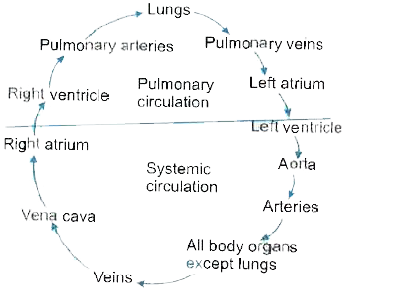Blood circulation in fishes is different from the blood circulation in human beings." Justify the statement
(b) Describe "blood circulation" in human beings.
Text Solution
Fishes have two-chambered heart - one ventricle and one auricle. The blood is pumped into gills where it is oxygenated and supplied directly to body parts from gills. Thus, blood goes only once through the heart.
(b) Double circulation is the passage of the same blood twice through the heart, first on the right side then on the left side in order to complete one cycle. Double circulation has two components:
Pulmonary circulation and systemic circulation.
Pulmonary circulation - It is the movement of blood from heart to the lungs and back. Deoxygenated blood of the body enters the right auricle, passes into rights ventricle which pumps it into pulmonary arch. With the help of two separate pulmonary arteries the blood passes into the lungs. Here the arteries break up into arterioles and then capillaries for oxygenation. Capllaries join to form venules and then veins. Oxygenated blood comes back to the left auricle of heart through pulmonary veins.
Systemic circulation – It is the circulation of blood between heart and different parts of the body except lungs. Oxygenated blood received by left auricle passes into left ventricle. The left ventricle pumps it into aorta for supply to different body parts. Inside the organs the arteries break up into arterioles and then capillaries. Capillaries provide oxygen and nutrients to tissues. Capillaries unite to form venules which join to produce veins. Veins take the deoxygenated blood to the heart but now into the right auricle.
Significance of double circulation - It ensures quick and efficient supply of oxygenated blood to all body parts for meeting higher energy needs and for thermoregulation of body in mammals and birds.

|
Updated on:21/07/2023
Related Playlists
- BOOK - U-LIKE SERIESCHAPTER - CBSE EXAMINATION PAPER 2020 (SOLVED)EXERCISE - Section - A22videos
CBSE EXAMINATION PAPER 2020 (SOLVED)
- BOOK - U-LIKE SERIESCHAPTER - CBSE EXAMINATION PAPER 2020 (SOLVED)EXERCISE - Section - B15videos
CBSE EXAMINATION PAPER 2020 (SOLVED)
- BOOK - U-LIKE SERIESCHAPTER - CBSE EXAMINATION PAPER 2020 (SOLVED)EXERCISE - SECTION B26videos
CBSE EXAMINATION PAPER 2020 (SOLVED)
- BOOK - U-LIKE SERIESCHAPTER - CBSE EXAMINATION PAPER 2020EXERCISE - SECTION C25videos
CBSE EXAMINATION PAPER 2020
- BOOK - U-LIKE SERIESCHAPTER - CBSE SAMPLE QUESTION PAPER 2019 - 20 (SOLVED)EXERCISE - SECTION A10videos
CBSE SAMPLE QUESTION PAPER 2019 - 20 (SOLVED)
Similar Questions
Blood circulation in insects :
View SolutionExplain the blood circulation in humans.
View SolutionBlood circulation is open in
View SolutionHow does blood circulate in human body?
View SolutionBlood circulation in earthworm is :
View SolutionBlood circulation in earthworm is :
View SolutionOpen blood circulation is found in
View SolutionOpen blood circulation is found in
View SolutionOpen blood circulation is found in
View SolutionType of blood circulation in amphibians is
View Solution

